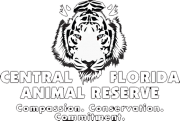Hurricane Matthew is a significant storm, and has the potential to have a huge impact on the state of Florida. With over 2 million new residents to the state since the last major storm, people are scrambling to get ready with food, water, and supplies.
For Central Florida Animal Reserve, that preparation started way back in 2004, when the site was first faced with such a weather challenge. Four hurricanes rocked the state–leaving a slew of destruction and lessons in its wake.
Contingency planning has been put into effect to prepare for the event. Volunteers and staff have descended on the property to harden the site ahead of the storm. Among the many tasks to be accomplished, shade tarps are being removed to avoid being caught by the wind while tools, outdoor furniture, and objects that may be picked up by high winds are secured. The open construction of the enclosures allows the strong winds to pass through enclosures with little resistance–a lesson learned from observation during the previous storms.
We thank everyone who has reached out to ensure that our residents are safe. Teams are on standby, both locally and inland to support recovery efforts. Florida’s Fish and Wildlife Commission (FWC) is partnering with us to ensure that we have needed supplies and double checking resources.
The safety of our resident animals and the volunteers that serve them is paramount, and we encourage everyone within the storm’s path to prepare appropriately!
Where do big cats go in a storm?
Whether it be a typhoon or monsoon, big cats have a remarkable ability to survive nature’s fury. They may shelter in a cave, hide behind larger objects as a windbreak, or find a den in a thicket.
The cats at Central Florida Animal Reserve have similar instincts, and position themselves inside their wooden dens to ride out the storm. They wait out the weather in the safety of sturdy homes–tended on a regular schedule by on-site staff dedicated to keeping them safe, rain or shine.

